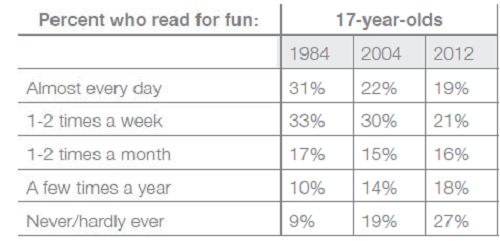When I was a student in general school, cable-television in the classroom was the big trend. Today, the technology you are more likely to see in the classroom are tablets, e-readers, and laptops — devices that are both exponentially more interactive and distractive. The prospect of using these devices may excite most students, but then there are those who worry that distractions and “self-paced learning” don’t impart the same level of education.
One student, Jonathan Wulffleff, 15, an eighth grader from Strayer Middle School in Quakertown, PA, is a fan of cyber courses as a supplement to standard face-to-face classes. “If you have issues, you can watch the video again,” he said. “With a class, you only get it once and you have to remember it.”
However, Jonathan proceeds to cautioned that “distraction-related” issues caused him to their share of grievances. “I slipped for a little while and was really upset, because last year I did really well.”
Two older students, Cheyenne Knight, 18, and Brian Benes, 17, who have both completed cyber lessons in a lab at Quakertown Community High School, hold differing opinions. Cheyenne feels that her cyber classes didn’t seem as rigorous as “live” classes since tests were open book and did not require any memorization. Brian disagrees, suggesting that the challenges in a live classroom are often memorization, and in the real-world people don’t usually hover over your shoulder, verifying if you’ve memorized something. Cheyenne thinks cyber education takes away from social interaction; meanwhile, Brian thinks the limited social interaction with fellow cyber lab students is sufficient. Both agree that cyber-education teaches how to function in a tech-savvy era, but face-to-face education has its own benefits.
Dip in reading frequency correlates with increased tech usage
A recent report compiled by the nonprofit Common Sense Media compares reading time between teenagers in 1984 to 2004 and 2012. Not surprisingly, the number of 17-year-olds who read daily decreased from 31% to 19% between 1984 and 2012, while the number of those who hardly read, or never read, increased from 9% to 27%.
Studies have found that a variety of factors influence how frequently children read. Not only do gender, family income, and parents’ level of education factor in, but so too does the number of print books available, how often do the parents read, and the teenager’s freedom to pursue his/her own hobbies.

Benefits at a young age
Proponents of interactive tech-centered education find that with young students in particular are more capable of using technology as a supplement for abstract thinking, and creating the association from a much earlier age will enable them to use technology more responsibly.
An experiment performed at Georgetown University divided children between the ages of 30 to 36 months into three groups and each received a different version of a hide-and-seek puppet show. Group A saw it live, Group B watched a recording of the live show, and Group C played an interactive computer game that displayed puppet location whenever the kids pressed the spacebar.
Once the sessions were finished, the children were sent to the actual room to locate the puppets. Those who watched the live or record videos discovered puppets by trial and error, whereas, Group C walked directly to where the puppets were located.
In a separate instance, a New Jersey teacher named Chris Crowell has been infusing technology into his lessons since the floppy-disk days of yore, finds that technology has been a tremendous help in stimulating children’s imagination. Today, his classroom has three iPads and a laptop, that students are invited to use (with his permission) to explore their own curiosities. In one instance when a spider was discovered in the kitchen area, Chris piques the students’ interest by inviting them to view the creature under a microscope. Fueled by excitement,the students set-up the laptop and USB microscope on their own using the skills they’ve learned from having access to free play at the designated stations where the gadgets are located.
Engagement vs. addiction
The question is not whether or not increased tech consumption is directly responsible a decrease in reading frequency, but whether the availability of tools with easy access to entertainment should force families to re-evaluate their parenting methods. According to Common Sense Media’s 2014 report on children and teen reading habits, reading scores for young children have been steadily improving in recent years, while they’ve been stagnating among adolescents for decades. Reading proficiency is higher than twenty years ago, but one in three fourth-graders still read at a basic level. These issues are more likely to correlate with how the tool (technology) is used, rather than the tool itself.
There are more reading platforms available than ever, thanks to tablets, e-readers, laptops, and smartphones, so perhaps it’s up to the parents not only regulate exposure time, but the type of activity as well.
Advertisement
Learn more about Electronic Products Magazine





